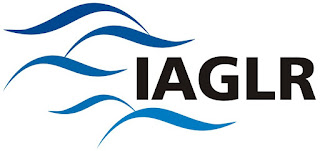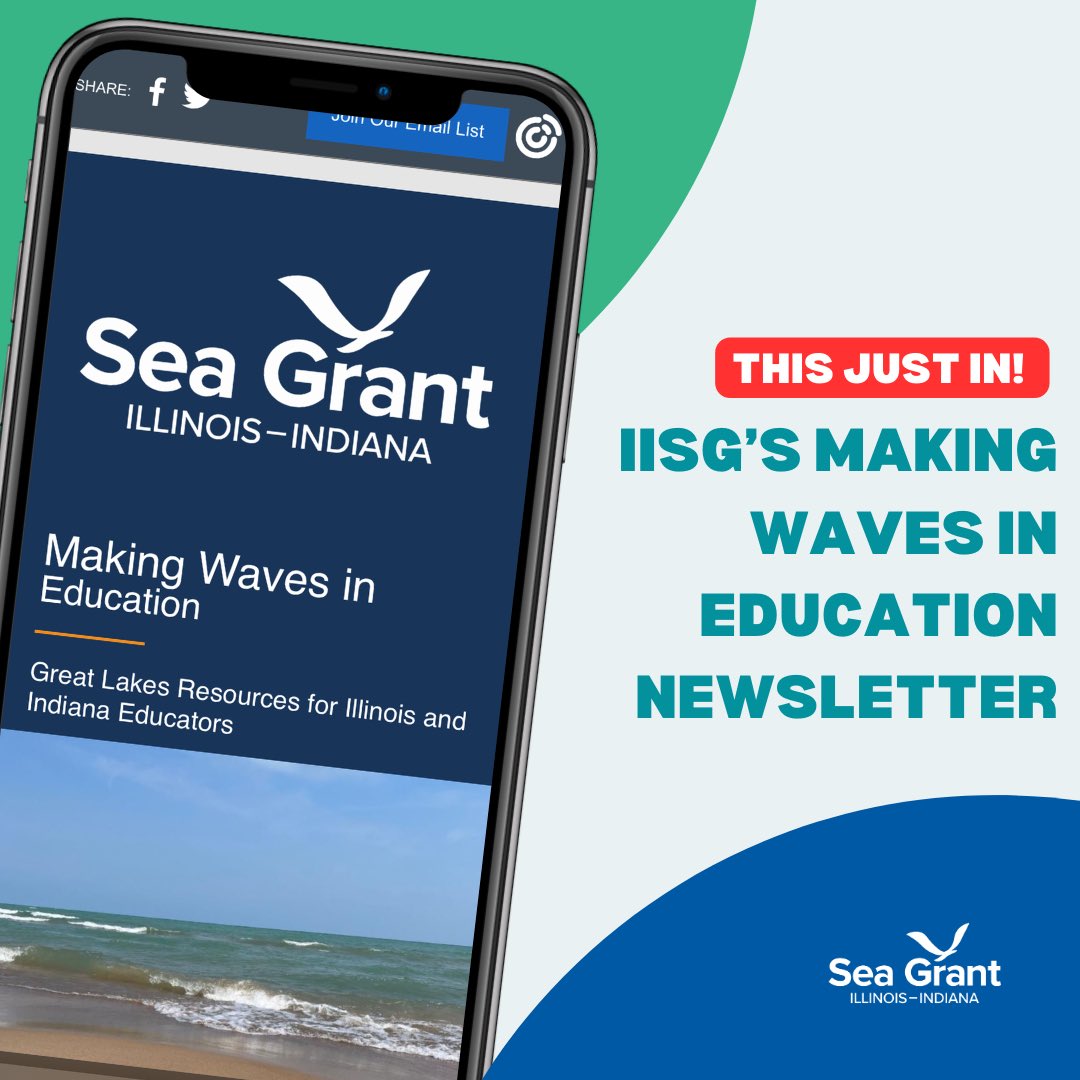October 10th, 2018 by Hope Charters
Crystal Hall is interning with Illinois-Indiana Sea Grant (IISG) as a recent graduate of Purdue University Northwest (PNW) with a B.S. in Biology and a concentration in Ecology. Funded by IISG and mentored by Leslie Dorworth, an aquatic ecology specialist with IISG and PNW, Hall is positioned with the U.S. Geological Survey to carry out work that moves projects forward through IISG, the U.S. Army Corps of Engineers and the Indiana Department of Environmental Management.
When I started my internship working with the U.S. Geological Survey (USGS), I had no idea what I wanted to do career-wise other than something with fish. To be honest, I still don’t fully know. Over the six months I have spent at USGS, I have learned a great deal of information and have gotten to know a wonderful group of people.
I have worked on several projects and learned new things from each:
Round Goby Mesocosm
The purpose of the round goby mesocosm project is to look at the shed and decay rates of round goby DNA in water and sediment. Several round goby were placed into a tank, and weekly water and sediment samples were taken for environmental DNA (eDNA). After a set amount of time, the round goby were removed and weekly water and sediment samples continued to be taken to see how long before no round goby DNA was detected. Throughout this project, I learned a lot about eDNA and how concentrations are different in water and sediment.
Cladophora
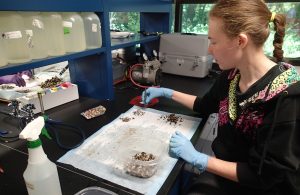
Hall separates zebra mussels from quagga mussels on June 4, 2018. (Photo U.S. Geological Survey)
On the Cladophora project, we deployed EXO2 water quality sondes in the Great Lakes and collected samples of dreissenid mussels and Cladophora algae from several depths and quadrants for biomass and nutrient processing. Researchers are seeking to understand the influence of phosphorus on Cladophora growth. I have learned to successfully identify zebra mussels from quagga mussels. And I’ve learned that it is not zebra mussels invading the Great Lakes anymore—it’s quagga mussels.
Area of Concern
We test for E. coli in the water at Whihala Beach and Hammond Port Authority, which are part of the Grand Calumet River Area of Concern. This information is used to notify the public of whether the beach is safe for swimming. Scientists used to test several other beaches in the area as well, but many were removed from the project because the water quality improved and met standards.
Artificial Reef
A year ago, an artificial reef was put in at Jeorse Park Beach by the U.S. Army Corps of Engineers as part of a large-scale restoration project for the beach. The U.S. Army Corps were hoping the reef would attract a number of native fish species that had once been in the area. In the artificial reef project I’m working on, I am assisting a master’s student with research that aims to see if this artificial reef has actually attracted native fish, or if round goby have colonized the reef since they’re attracted to rocky substrate.
Monthly water samples are taken and filtered for eDNA from several locations at Jeorse Park Beach, including surface water samples at the reef and water samples right above the substrate of the reef. After the sampling is complete, the DNA will be sequenced using fish primers for fish found in Lake Michigan to determine the composition of fish in the water based on the eDNA. Part of the project will be comparing the eDNA to traditional methods of monitoring (e.g., electroshocking).
I’ve learned so much. Before this internship, I knew nothing about freshwater reefs and artificial reefs. I didn’t know that breakwalls altered the flow of water in a way that can cause a buildup of E. coli and lead to unsafe water conditions. When I began my internship, everyone would talk about ongoing projects and try to inform me about the details of each one, but there was a lot that I didn’t understand. I’m proud to say that has changed, and now I am able to explain to others the projects we are doing, why we are conducting research in certain ways and what we are hoping to find.
I’m thankful for the opportunity to intern at USGS through Illinois-Indiana Sea Grant and to work with a great group of people. I have definitely gotten more out of my internship than I was ever expecting, and while I still don’t know what I would like to do as a career choice, I’ve discovered that working on projects like these is certainly an option and something I very much enjoy.
Learn more about our internship opportunities online, or contact Angie Archer at (765)496-3722, amcbride@purdue.edu.
Illinois-Indiana Sea Grant is a part of University of Illinois Extension and Purdue University Extension.
November 16th, 2016 by IISG
The first of hopefully many recreational fishing workshops brought together more than 40 researchers, managers, stakeholders, and anglers last week to Hammond Marina in Indiana to learn about food web research, updates on fisheries, and ongoing monitoring in southern Lake Michigan.
Mitchell Zischke, IISG research and extension fishery specialist, organized the event.
“I have presented research at similar workshops for Lake Huron hosted by Michigan Sea Grant. These workshops were well attended and a great opportunity for anglers, scientists, managers, and others to interact,” said Zischke. “I wanted to develop a similar program for southern Lake Michigan, particularly in light of recent ecosystem and fishery changes like the declining populations of alewife.”
The five speakers hailed from NOAA Great Lakes Environmental Research Laboratory, U.S. Geological Survey Great Lakes Science Center, U.S. Fish and Wildlife, Ball State University, and Illinois Natural History Survey.
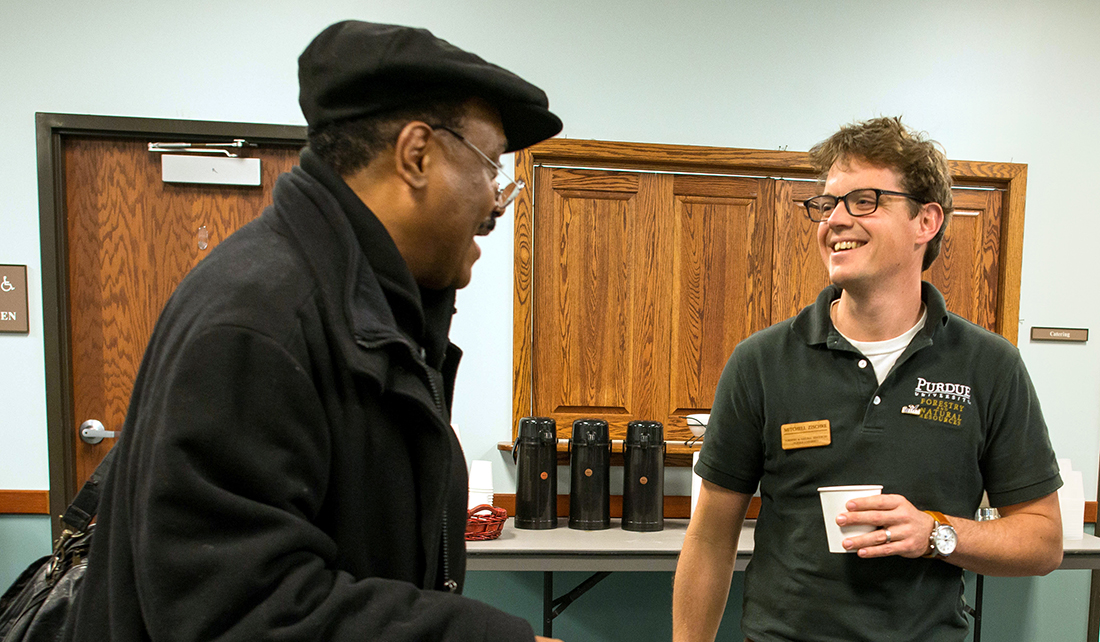
Mitchell Zischke, IISG research and extension fishery specialist, pictured on the right, organized the event.
Topics included recent changes in the base of the food web, status and trends of prey fish, mass-marking of Chinook salmon and lake trout, long-term monitoring of yellow perch, and angler surveys and the recreational fishery focusing on the Illinois waters of Lake Michigan.
Howard Petroski, known as “Captain Ski,” ran Paradise Charters out of East Chicago for 25 years until it shut down about 14 years ago. Even though he now just fishes recreationally, he still follows what’s happening in Lake Michigan.
“What they’re showing with the decline of the perch was pretty obvious, but now it’s more obvious that they showed it on the charts,” Petroski said.
According to Zischke, this first workshop just scratched the surface on topics relevant to anglers in southern Lake Michigan.
“There were actually more people willing to present than I could fit in the workshop agenda. We hope that these workshops can become an annual event in both Indiana and Illinois, that way we can continue to provide anglers and other lake-users with up-to-date information on the Lake Michigan fishery and ecosystem as a whole. In fact, attendees at our recent workshop said that they can’t wait for the next one!”
Illinois-Indiana Sea Grant is a part of University of Illinois Extension and Purdue Extension.
February 29th, 2016 by IISG
There are reefs in the Great Lakes?
That was my first thought when I sat down to interview for a field technician position in the fall of 2014. I had been working at a tech job at Purdue University, but I felt that it was time for a change–to something that was a bit more interesting to me. When I had the chance to interview to be a field tech on a fish ecology project, I knew that the time for change had arrived. But working on reefs? Coral, colorful, vibrant reefs teeming with a spectacular array of exotic fish species? I asked the post-doctoral fellow conducting my interview, Dr. Mitchell Zischke, if those were the kind of reefs he was talking about.
“Not quite,” said Mitch. “Reefs in the Great Lakes are rocky, made of cobble, gravel, and other stony fragments.” Ah. That’s very different than the vision most people get when they think of underwater reefs. A lot of publicity is directed towards oceanic coral reefs and their current plight worldwide, and rightly so. But I think sometimes that comes at the expense of exposure to unique and threatened environments much closer to home. The reef systems of the Great Lakes are a prime example.
I say this based on my own experiences as a native of the Great Lakes region. I grew up in a small town in western Michigan, right on the shores of Lake Michigan. My family often traveled around the state, spending time at all of the Great Lakes. Yet I never heard mention of any rocky reefs. I’d wager that outside of die-hard fishermen, most citizens of the region haven’t been exposed to our local reefs, either. Going forward, I’m hopeful that a lot of exciting research on the Great Lakes is about to change that fact.
That’s how my current project fits into all of this. It turns out that I liked being a fisheries ecology technician enough that it led directly into graduate school at Purdue University. I am now a Master’s student under the guidance of Dr. Tomas Höök, associate professor at Purdue and associate director of research for Illinois-Indiana Sea Grant. Along with many other organizational partners (including Michigan Sea Grant, Michigan Department of Natural Resources, Michigan Department of Environmental Quality, U.S. Fish and Wildlife Service, and the United States Geological Survey, to name a few) we are in the beginning stages of potential rocky reef restoration in Saginaw Bay in Lake Huron.
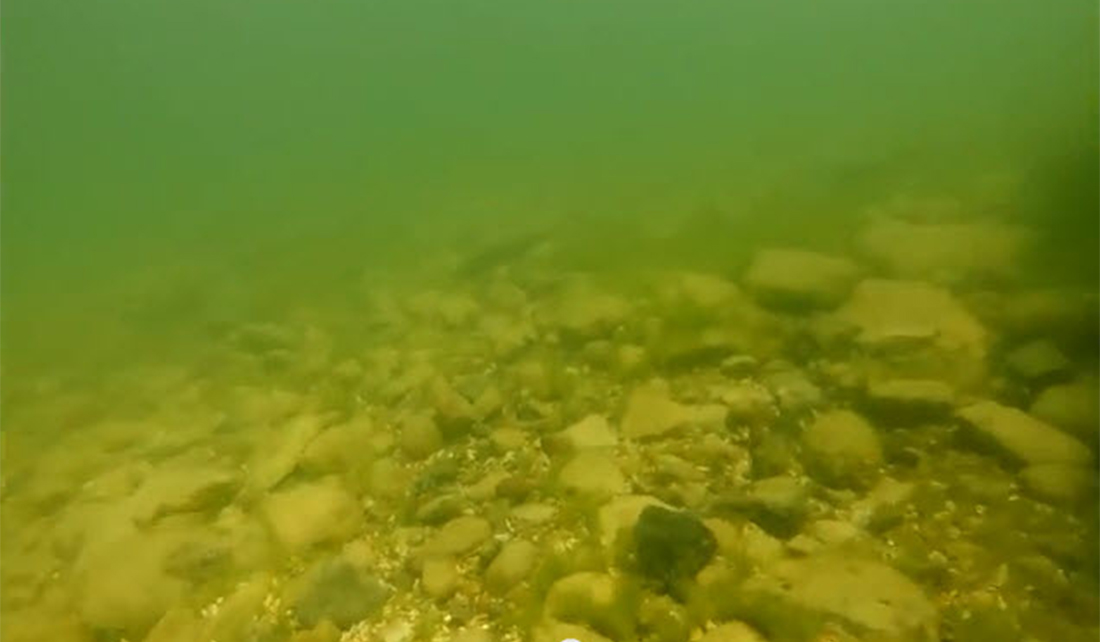
To understand why reef restoration in Saginaw Bay is a good idea, a little historical background is important. Years ago, Saginaw Bay was the second largest walleye fishery in all the Great Lakes, and had a healthy population of fish spawning on rocky reefs in the bay. These reefs provided many benefits to incubating eggs, including excellent protection from predators. Long-term sedimentation and poor land use led to most of those reefs being lost. This had profound negative impacts on walleye, as well as on other recreationally- and commercially-important fish species. Today, the walleye population has recovered, but the fish spawns almost completely in tributary rivers that feed into Saginaw Bay, rather than the bay itself. Reef restoration would allow walleye to have prime spawning habitat in the bay once more, and hopefully encourage these fish to resume using some of their historic spawning grounds. Beyond the obvious benefits to an increased amount of spawning area, this would also pave the way for a more geographically- and genetically-diverse walleye population. Such diversity could prove very important during times of stress. Of course, many other fish species, such as lake whitefish, would also be able to use restored reefs.
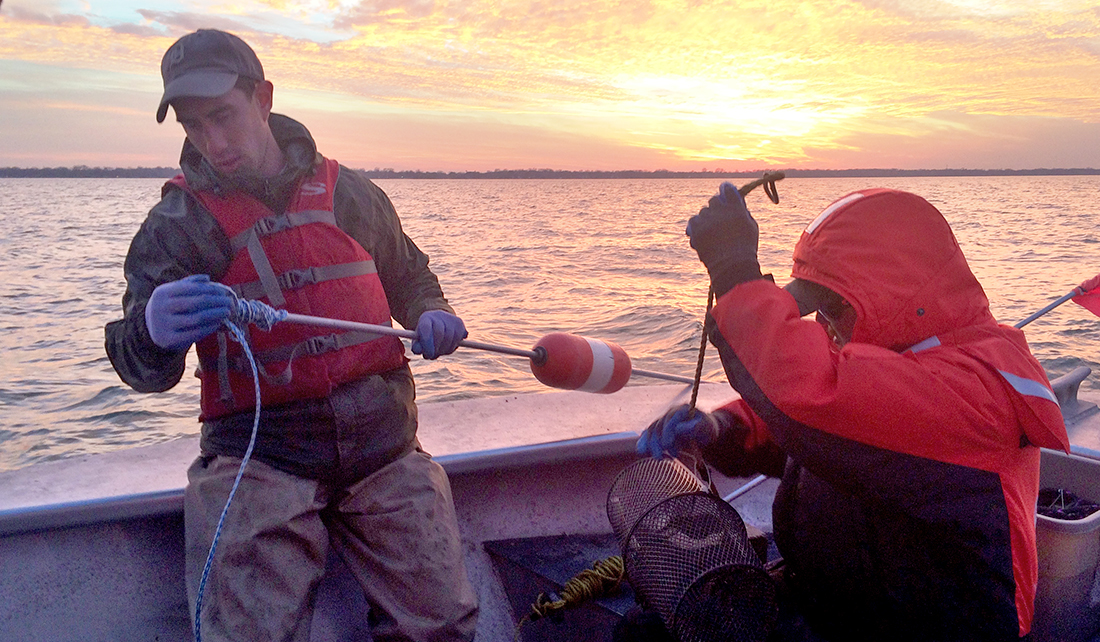
However, before rocky reef habitat could be restored in Saginaw Bay, we needed to make sure that restoration would have a good chance of being successful. Restoration projects are never cheap, and we wanted to be sure that funding was being wisely spent. That’s where my specific project comes in. A small field crew, comprising members of Purdue University (including me, Dr. Zischke, and Jay Beugly, who also serves as an aquatic ecology specialist for Illinois-Indiana Sea Grant) and the USGS, was tasked with assessing current spawning patterns within Saginaw Bay. Essentially, we wanted to see what currently degraded reef sites looked like, whether key species like walleye and lake whitefish were spawning near those degraded sites, whether they were depositing eggs, and whether predators were around to eat those eggs. If we could say that water quality was decent, target species were spawning in the area and depositing eggs, and that egg predators weren’t too abundant, we might have a reasonable shot at successful reef restoration.
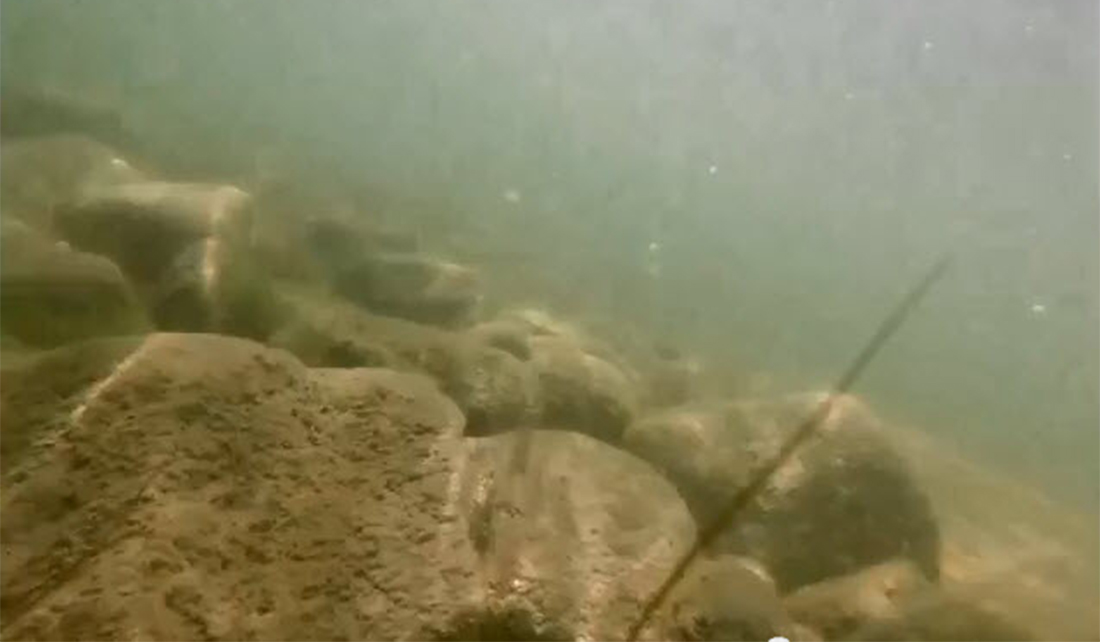
We’ve been at it since late 2014, and though results are still preliminary, there are some positive signs. Water quality is good, and some sites look receptive to adding additional reef structure. Spawning walleye and lake whitefish are being found across the bay, and they’re depositing eggs, too. Numbers of fish and eggs are low, but the fact that fish exist to take advantage of potentially restored reefs is hugely important. We’ve also found that egg predators are present, but that the biggest predation risk is probably from large-bodied fish like common carp and catfish. Given these findings, we are optimistic that rocky reef restoration can be successful in Saginaw Bay. Hopefully, restored reefs will attract higher numbers of fish to spawn, while simultaneously providing cracks and crevices to help eggs avoid large egg predators.
If everything goes right, reef restoration in Saginaw Bay could be going on long after I’ve left Purdue. Really, I think that’s one of the coolest things about this project: It has so much potential. With many groups involved, like Sea Grant, and tons of habitat to restore, reef restoration could be the definition of a long-term undertaking. Who knows, maybe I’ll find myself back on the familiar shores of Saginaw Bay one day, working once more on a project that helped launch what I hope will be a long career in fisheries science. For now, I’m just focused on the upcoming field season. It’s the last chunk of field work in our spawning assessment. If we keep finding some of the same patterns, I’m very excited for the future of reef restoration in Saginaw Bay and across the Great Lakes.
February 5th, 2015 by iisg_superadmin
Fisheries managers have long known that the population of rainbow smelt in the Great Lakes is on the decline. Once so abundant that they could be fished out with a pot or strainer, this important prey fish survives today in numbers hovering near historic lows. Numerous causes for the falling population have been proposed, but new research suggests that the population patterns and the forces driving them are more complicated than previously believed.
 The 2014 study reveals that number of smelt that survive their first few months has actually been on the rise since 2000. But this increase in hatchlings isn’t translating into more adults, and it is unclear when and why that breakdown is happening. Whatever the cause, the loss of adult rainbow smelt is enough keep the population trending down even as offspring survival improves.
The 2014 study reveals that number of smelt that survive their first few months has actually been on the rise since 2000. But this increase in hatchlings isn’t translating into more adults, and it is unclear when and why that breakdown is happening. Whatever the cause, the loss of adult rainbow smelt is enough keep the population trending down even as offspring survival improves.
Researchers from USGS, IISG, Purdue University, and the U.S. EPA Great Lakes National Program Office, discovered the unexpected increase in offspring after analyzing roughly 40 years of fisheries data using a novel modeling technique.
Fish populations are typically analyzed using a statistical model that that assumes the relationships between different variables—things like number of offspring, number of adults, degree of predatory pressure, and amount of rainfall—remain the same over time. For this study, researchers used statistical tools rarely used by fishery scientists that better reflect the ever-changing nature of the Great Lakes and make it possible to detect more subtle population patterns.
Perhaps most surprising is that offspring survival is on the rise in Lake Michigan despite the fact that their parents are up to 70 mm shorter now than they were in the 1970s.
“We were expecting to see a decrease in productivity because the adults are maturing at smaller sizes, which should mean fewer eggs and less healthy hatchlings,” said Zach Feiner, a PhD student at Purdue University and lead author of the study. “This raises a lot of questions about how well we understand rainbow smelt fisheries.”
Researchers speculate that the drop in the number of adult smelt may actually be allowing hatchlings to thrive. Adult rainbow smelt frequently supplement their diet of zooplankton by dining on their offspring. Fewer adults means fewer predators for juvenile smelt. The need to find food in a lake infested with millions of quagga and zebra mussels that filter out plankton may also be driving adults further out into the lake and away from spawning grounds.
***Photo courtesy of Crystal Lake Mixing Project.
October 8th, 2014 by iisg_superadmin
Today we take a break from discussing the latest Great Lakes research to recognize one of the scientists who laid the foundation for modern water science.
From the U.S. Geological Survey’s Science Features:
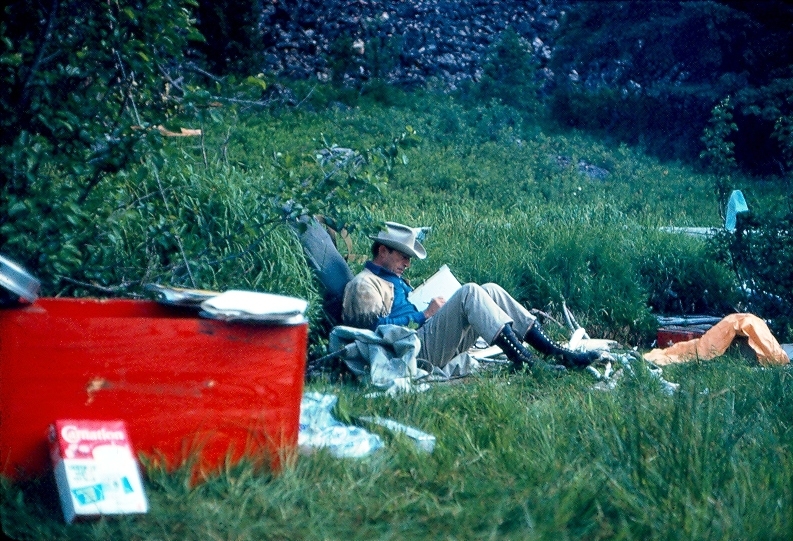 Luna B. Leopold, son of famed conservationist Aldo Leopold, arrived at the USGS in 1950. For the next two decades, Leopold revolutionized hydrologic sciences within and outside the USGS. He is best known for his work in the field of geomorphology, the study of land features and the processes that create and change them. His work is often cited today by leading scientists in water research, both at the USGS and around the world.
Luna B. Leopold, son of famed conservationist Aldo Leopold, arrived at the USGS in 1950. For the next two decades, Leopold revolutionized hydrologic sciences within and outside the USGS. He is best known for his work in the field of geomorphology, the study of land features and the processes that create and change them. His work is often cited today by leading scientists in water research, both at the USGS and around the world.
Leopold had a lasting impact on the field of water science. He knew the broader importance of our water resources and that humans can have great impact on whether water is available, now and in the future. Our society depends on safe and reliable water supplies, as do the Earth’s diverse and valuable ecosystems. Today, our nation is faced with the challenge of balancing a finite freshwater supply between competing needs, such as agriculture, drinking water, energy production, and ecosystems.
Leopold recognized the fundamental value of science in making smart decisions about water resources and laid the groundwork for modern water science. During his tenure he transformed USGS water research into a professionally-recognized provider of water quality and availability information.
For six years, he served as a hydraulic engineer before becoming the first Chief Hydrologist in the history of the USGS, a position he held until 1966 when he stepped down to pursue his research. While at the USGS, he led the effort to restructure the water science programs to focus on viewing water as a single resource. For example, USGS continues to research the interactions between surface water and groundwater, because use of either of these resources affects the quantity and quality of the other.
***Leopold writes down his reflections during a 1966 research expedition in Idaho. Photo courtesy of USGS.
March 17th, 2014 by iisg_superadmin
Research into the Lake Michigan food web has increased in the last decade, but there are still a lot of questions—exactly what is eating what, and how is that dynamic affected by environmental changes? To find answers to these and other questions, researchers from federal and state agencies, universities, and non-profit organizations will come together next month in Ann Arbor, MI. The two-day meeting will feature discussions on past and current food web studies and end with a plan for future research.

The meeting kicks off April 1 with presentations on several Sea Grant- and EPA-funded studies. IISG’s Tomas Hook, Sergiusz Czesny, director of the Lake Michigan Biological Station, and Bo Bunnell of the USGS Great Lakes Science Center will discuss the state of Lake Michigan fish populations, including the results of a three-year investigation of the differences in nearshore food webs across the lake. Harvey Bootsma, a researcher at the University of Wisconsin-Milwaukee, and NOAA’s Henry A. Vanderploeg will also be onsite to talk about recent findings on the diets of phytoplankton, algae, and other species at the bottom of the food chain. Additional presentations, orchestrated by IISG’s Paris Collingsworth and featuring IISG-funded scientist Cary Troy, will talk about research on the physical dynamics of the lake and steady flow of nutrients brought in by stormwater runoff—two important factors affecting food web structures. Paris will also introduce plans for upcoming monitoring and field activities in Lake Michigan as part of the Cooperative Science and Monitoring Initiative.
Conversations on the second day will turn to planning. IISG research staff will team up with representatives from the Wisconsin and Michigan Sea Grant programs to lead discussions on data still needed to understand how invasive species, contaminants, climate change, and other factors are affecting the Lake Michigan food web. Meeting attendees will also have an opportunity to briefly talk about their research and where they hope to go next. The gaps and next steps identified will help Lake Michigan Sea Grant programs identify research projects to fund in the coming years.
This meeting is the third of its kind since 2008. And, like those before it, this year’s meeting is coordinated by IISG and GLRRIN Lake Michigan partners from Wisconsin Sea Grant, Michigan Sea Grant, the NOAA Great Lakes Environmental Research Laboratory, the US EPA Great Lakes National Program Office, and the USGS Great Lakes Science Center. Previous meetings helped launch the 2010 Lake Michigan Intensive Monitoring Field Year and resulted in roughly $1.7 million in funding for food web projects.
To learn more about the meeting and how to attend, contact Carolyn Foley. And stay tuned for instructions on how to stream this meeting in real time.
March 6th, 2014 by iisg_superadmin
Quagga and Zebra mussels have been a problem for waterways including the Great Lakes for decades, but there may finally be a targeted solution that can significantly reduce their numbers without disrupting other organisms.
“Now the mussels may have met their match: Daniel P. Molloy, an emeritus biologist at the New York State Museum in Albany and a self-described ‘Bronx boy who became fascinated by things living in water.’
Inspired by Rachel Carson’s ‘Silent Spring’ in high school, Dr. Molloy, now 66, has long been a pioneer in the development of environmentally safe control agents to replace broad-spectrum chemical pesticides.
As a result, New York State has awarded a license to Marrone Bio Innovations, a company in Davis, Calif., to develop a commercial formulation of the bacterium. The product, Zequanox, has been undergoing tests for several years, with promising results. (Dr. Molloy has no financial ties to the company.)
Zequanox killed more than 90 percent of the mussels in a test using tanks of water from Lake Carlos in Minnesota, said James A. Luoma, a research biologist with the United States Geological Survey in La Crosse, Wis. A control group of freshwater mussels, unionids from the Black River in Wisconsin, were unharmed.”
Read the rest of the article at the link above.
August 7th, 2013 by Irene Miles
Researchers at the University of Illinois, working with the USGS and funded in part by Illinois-Indiana Sea Grant, have developed a modeling system that will help manage and prevent the spread of invasive Asian carp.
From Phys.org:
“The model, called Fluvial Egg Drift Simulator (FluEgg), follows a clutch of eggs over time as they travel downstream. Since carp spawn in turbulent waters, they seek places such as dams and spillways. To establish a large population in the Great Lakes, the carp would have to leave the lakes to spawn in the tributaries where the water moves rapidly, usually downstream from dams and spillways, where there is a lot of turbulence. The eggs have to stay suspended in the current to hatch – if they settle on the bottom, they die.
‘The challenge is, of all those million of eggs, how many of those end up hatching?’ said Marcelo Garcia, the U. of I. professor of civil and environmental engineering who led the project. ‘Our challenge has been to find a way to simulate this process from the spawning point all the way downstream. If the eggs are not kept in suspension, they will not be viable and they will die out. We have a model to look at certain streams – like tributaries to the Great Lakes – and figure out whether those streams are potential areas for Asian carp to reproduce. I think we have put together a tool that is going to be eye-opening, to say the least. It’s going to be a lot easier to visualize the transport and the conditions you need for hatching.'”
Read more about the model at the link above, and read about their outreach project here.
May 22nd, 2013 by Irene Miles
Dozens of researchers and government representatives will come together next month to present the latest research on Lake Michigan’s ever-changing food web during the Conference on Great Lakes Research. The session, held June 3-4, will be chaired by IISG’s Tomas Hook, along with David Bunnell from the U.S. Geological Survey and Hank Vanderploeg from NOAA.
Presentations will discuss a range of issues that help determine just what eats what in the lake. Several will focus on what happens to the diet of native species when invaders like quagga mussels, round goby, spiny water flea deplete food resources. Others will introduce how shifts in phosphorus and other nutrient levels may be behind recent changes at the bottom of the food web and compare the eating habits of forage fish over the last two decades.
The session is a part of ongoing regional efforts to improve understanding of the complicated relationships between the many different microbes, plants, and animals that call Lake Michigan home. Since 2010, IISG and other partners in the Great Lakes Regional Research Information Network have funded several studies on the links that form the food web.
“While researchers have been studying the Lake Michigan food-web for several decades, many of the interactions remain poorly described,” said Tomas. “And we are learning that there are very important regional differences in food web structures across Lake Michigan.”
In addition to serving as co-chair, Tomas will join researchers from across the Great Lakes to present the findings of three studies slated for the session. For a description of these and other presentations, visit the session schedule and click on the presentation titles.
The International Association for Great Lakes Research’s (IAGLR) 56th Annual Conference on Great Lakes Research is sponsored by IISG and Purdue University. To view the entire program, visit the conference website.









